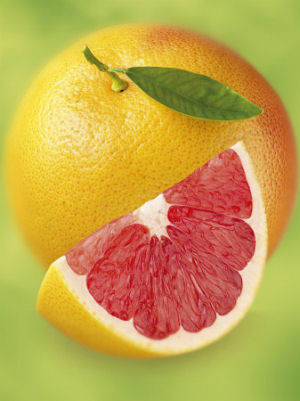
HOME
INTRO
SYMBOLS
ALMANAC
ECONOMY
GEOGRAPHY
STATE MAPS
PEOPLE
FORUM
NEWS
COOL SCHOOLS
STATE QUIZ
STATE LINKS
BOOK STORE
MARKETPLACE
GUESTBOOK
CONTACT US


Texas State Fruit
Adoption of the Texas State Fruit
The official State Fruit of Texas was adopted by House Concurrent Resolution No. 75 and signed by Governor Ann Richards on May 17, 1993.
H.C.R. No. 75
HOUSE CONCURRENT RESOLUTION
WHEREAS, The State of Texas has traditionally recognized a variety of official state symbols as tangible representations of the proud spirit and heritage of our state; and
WHEREAS, The bluebonnet, the pecan tree, and the mockingbird are examples of natural specimens that serve to exemplify the great diversity of the Texas landscape, while the state dish, chili, fittingly represents another aspect of our shared culture as Texans; and
WHEREAS, In keeping with this custom, the designation of the Texas Red Grapefruit as the official State Fruit of Texas will provide suitable recognition for this outstanding food resource; and
WHEREAS, First discovered by Texas citrus growers in 1929, this variety of grapefruit has been carefully nurtured and perfected over time and is renowned for its sweetness and rich, red interior; and
WHEREAS, As nutritious as it is palate-pleasing, the Texas Red Grapefruit contains no fat or sodium, lowers high levels of blood cholesterol, boosts iron absorption, is low in calories, and is rich in vitamin C; and
WHEREAS, This delicious fruit also is a boon to the state economy, generating more revenue than any other tree fruit produced within our borders; and
WHEREAS, As distinctive as the proud state from which it originates, the Texas Red Grapefruit will serve as a fitting emblem for the bounties of nature with which our state is blessed; now, therefore, be it
RESOLVED, That the 73rd Legislature of the State of Texas hereby designate the Texas Red Grapefruit as the official State Fruit of Texas.
Texas Law
Because the Texas Red Grapefruit was adopted by House Concurrent Resolution, it is not listed in the Texas Statutes.
Sources...
Bill Lookup. Texas Legislature Online. 2009. 1 April 2009
Shearer, Benjamin F. and Barbara S. State Names, Seals, Flags and Symbols: A Historical Guide Third Edition, Revised and Expanded. Westport, Conn: Greenwood Press, 3 Sub edition, 2001.

Texas State Fruit: Texas Red Grapefruit
Photographs, prints, and posters
Additional Information
Texas Grapefruit History: TexaSweet Citrus Marketing, Inc.
Citrus X paradisi Macfad. (pro sp.) (Grapefruit): USDA, NRCS. 2004. The PLANTS Database, Version 3.5 (http://plants.usda.gov). National Plant Data Center, Baton Rouge, LA 70874-4490 USA.
Citrus X paradisi Macfad. (pro sp.): Integrated Taxonomic Information System (ITIS) Here you will find authoritative taxonomic information on plants, animals, fungi, and microbes of North America and the world.
State Fruit: Complete list of official state fruit.
More symbols & emblems: Complete list of official Texas state symbols.

Texas State Fruit: Texas Red Grapefruit
from South Texas Organics
South Texas Organics: Purchase the official state fruit of Texas from South Texas Organics.
Citrus, by Lance Walheim. 112 pages. Ironwood Press (December 1, 1941) For anyone who grows citrus or wants to begin, this book offers a complete and up-to-date guide to selecting and growing more than one hundred varieties of oranges, mandarins, lemons, limes, grapefruit, and kumquats, as well as exotic citrus.
All About Citrus and Subtropical Fruits, Ortho; 2 edition (February 5, 2008) Grow your own citrus and subtropical fruit with help from All About Citrus and Subtropical Fruit. From detailed descriptions of over 70 varieties of citrus and 275 varieties of subtropical fruits, you are bound to find the best type for your garden. And don't forget the easy-to-follow care instructions that will ensure a bountiful harvest.
The Omnivore's Dilemma: A Natural History of Four Meals, by Michael Pollan. 464 pages. Penguin Press HC, The (April 11, 2006) The bestselling author of The Botany of Desire explores the ecology of eating to unveil why we consume what we consume in the twenty-first century
In Defense of Food: An Eater's Manifesto, by Michael Pollan. 256 pages. Penguin Press HC, The (2008) In looking toward traditional diets the world over, as well as the foods our families-and regions-historically enjoyed, we can recover a more balanced, reasonable, and pleasurable approach to food. Michael Pollan's bracing and eloquent manifesto shows us how we might start making thoughtful food choices that will enrich our lives and enlarge our sense of what it means to be healthy.
Garden tools from Amazon.com!
 Custom Search
Custom Search

